I well remember a conversation I had with German angling journalist and tackle designer Volker Dapoz a few years ago when fishing the Norwegian coast off Senja. We were up in to the early hours talking halibut, and his admiration, respect and sheer obsession with the king of all flatfish was obvious. It took just one halibut on my own rod a couple of years later to make me fall in to the same obsessive mindset.
These are special fish, immensely powerful, possessors of a wide tail giving them power, agility and a fast attack style. When halibut hit the lure its like an express train slamming in to a brick wall!
My only real chance of catching halibut is when I can get up in to the far north of Norway, which is all too rare. Here the clean, deep, sea fjords with their undersea mountains form the perfect habitat for this incredible fish.
I was representing WSF as part of a three man team comprising Ian Peacock, UK representative for Din Tur, the Norwegian adventure holiday company, and Editor of Total Sea Fishing magazine Barney Wright.
Our base was Oksfjord Sjofiske, a brand new angling centre based in Oksfjord in the county of Finnmark. The centre opens up virgin angling water and our little group was one of the very first to test the potential. There were no established marks in the chart plotter to work from, whatever we did would be by experimentation alone.
Looking over the charts we identified several areas we thought might produce halibut, but then halibut never read the script.
It was the second day and previously on the first night Ian and I had had quite a few cod just a couple of hundred yards or so out from the harbour breakwater in 25-metres of water so we elected to have a few drifts here first. I was fishing a yellow and red speed jig with a luminous muppet on the hook, just working it casually up off the seabed a few feet. Day dreaming of cod I wasn’t ready for the steam train take. Something whacked the pirk and turned straight back for the seabed.
It was a lively fight with the fish just taking a few yards of line now and then but slowly coming up through the water column. Half way up it ripped 10-yards back again then hung in the water. Working the fish it came in to view and a chorus of “It’s a halibut” rang out. Only a little fella some 8½ lbs in weight, but beautifully marked!
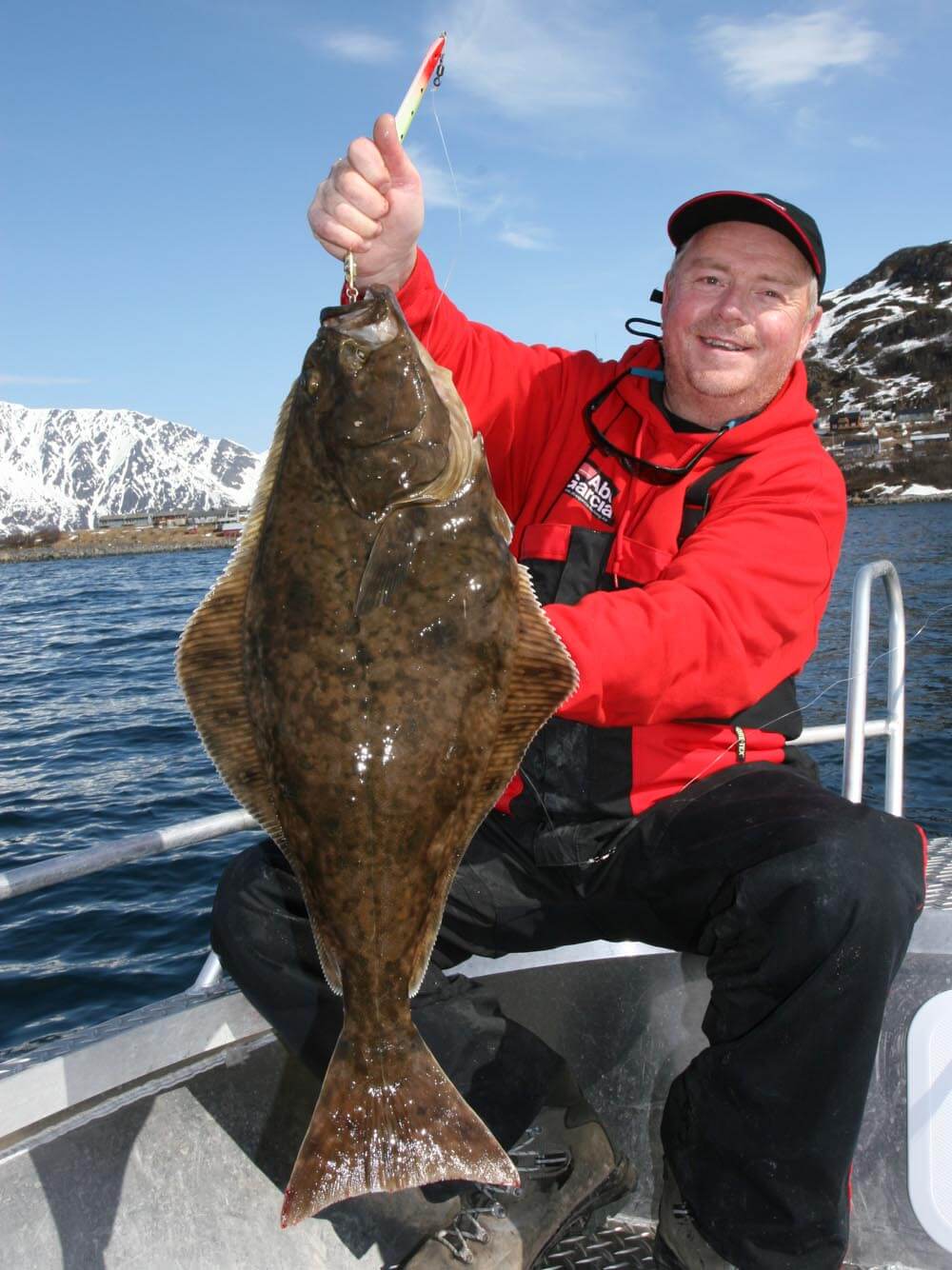
Two days later we set our whole day out to try for halibut. We wanted to check out some ground east of the fjord mouth towards a little bay called Oyvika. Here the ground rises to just over 20-metres, but falls quickly in to 100-metres plus. Halibut do seem to favour that 30 to 70-metre depth when you’re fishing close to shore.
It was windy but it helped the boat cover some good ground and the first few drifts produced cod, wolffish and torsk. The highest peak of the underwater ridge was under the boat and we were drifting slowly down the reverse side. Barney had set up with what was basically a Whitby rig comprising a boom and short 6ft trace of 80lb mono ending in a large shad with a curl tail. He was working the rod in short sweeps to give the shad movement. He was just about to lift the rod again when SLAM, his rod curved over and the fish ran for ground. It was stalemate for a moment then pressure lifted the fish and a short way up it went straight back for the seabed. It was a chilly wind coming in from the east, but Barney had beads of sweat on his brow as I picked up my camera and checked the light levels.
The fish made two more short runs then appeared as a blob of white way down. Ian was first to shout “halibut” and it rose through the water and sat quietly on the surface. Lifted aboard we weighed it at 24lbs.
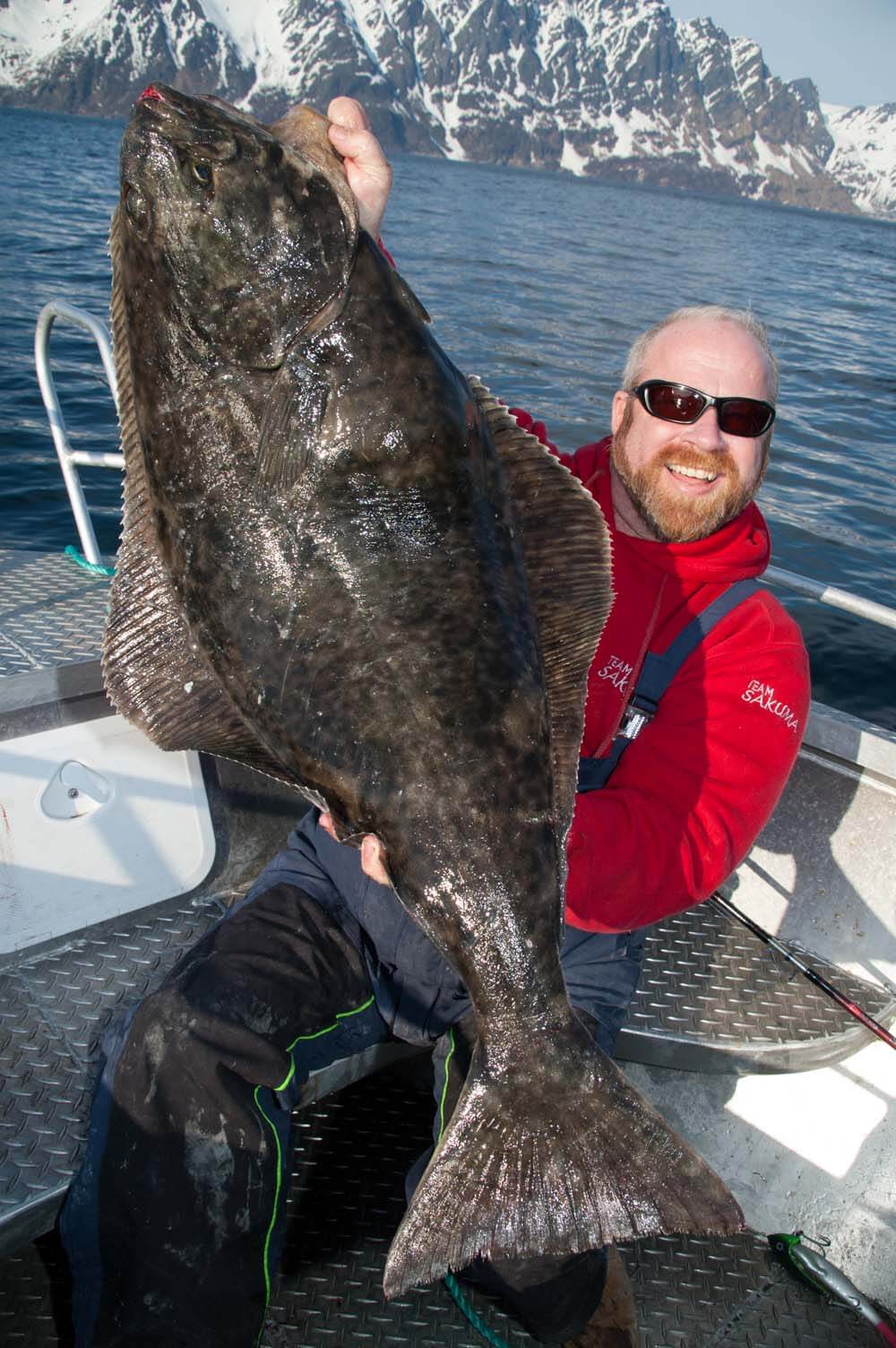
Ian had also changed now to a similar shad on the Whitby rig. A few drifts later we were almost at the bottom of the slope when his rod tip buckled over and line poured off the reel. It stopped only when the fish had run across the seabed a few more yards. He worked the fish hard and gradually it lifted off the seabed but dragged down the rod tip grudgingly as it rose.
It was half way up when the fish thought “enough” turned and went all the way back to the seabed again. The fight was more one sided now and Ian was gaining line quickly. We’d all guessed this was another halibut and sure enough that amazing broad grey/brown back looked up from the depths and broke surface. This one weighed 22lbs.
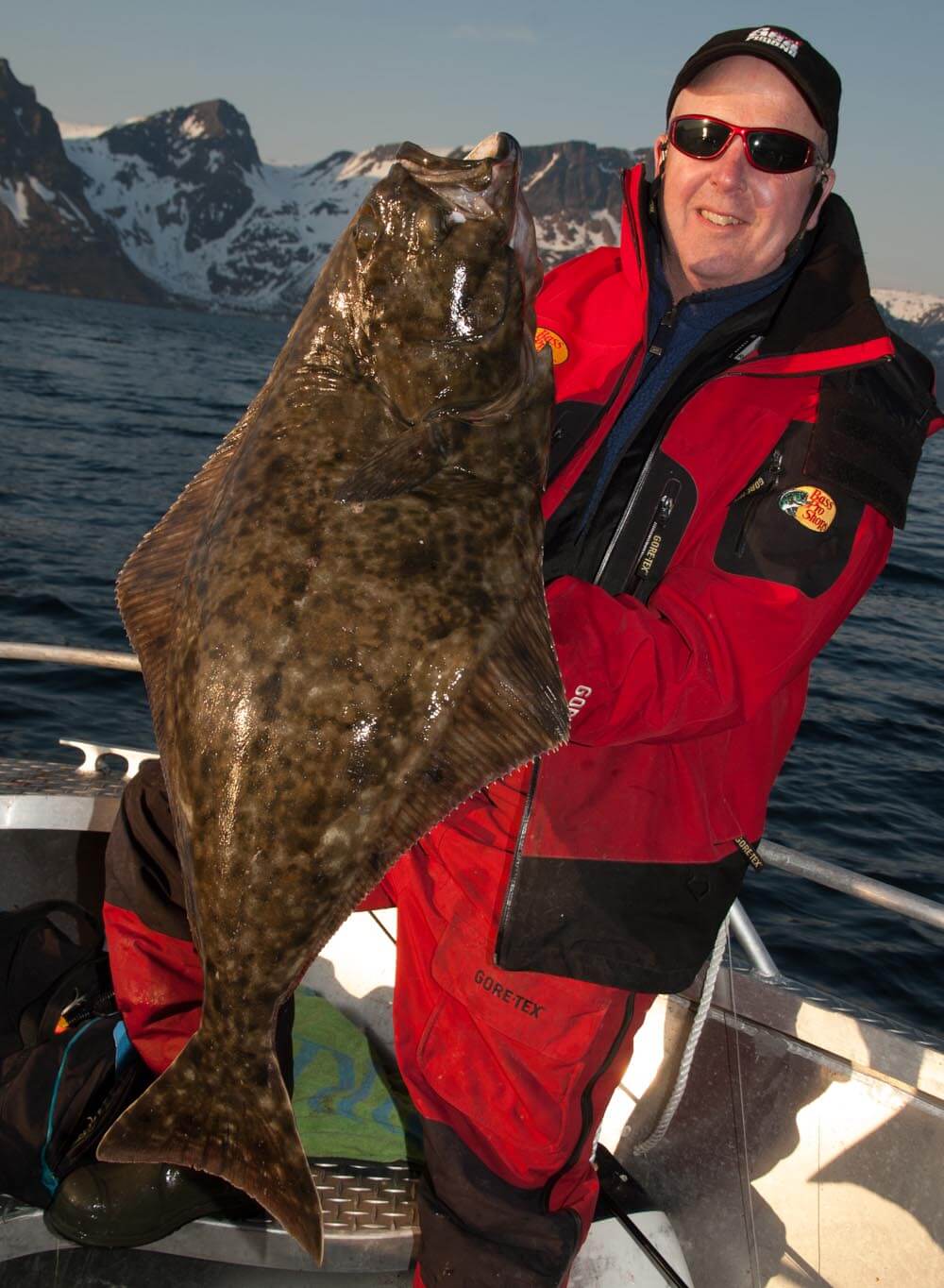
I was fishing one of Volker Dapoz’s Giant Jigheads in orange/yellow armed with a big black grub. I find these Jigheads highly effective and use them in preference to pirks. They swim like a real fish with limited rod tip movement and give a big silhouette to predators looking upwards off the seabed. My confidence was about to rewarded.
We were almost thinking of calling it quits for the day, but drifting over the peak we’d only dropped in to 30-metres or so just behind a vertical shelf when my Jighead was grabbed by an adversary that went parallel along the seabed for some distance, then stopped. Pumping the fish up off the seabed it hung there barely moving until it was about half way up, then gave away its identity by changing direction and ripping 15-metres of line or more off the reel. I actually felt the fish touch the seabed and turn away as it did so.
We knew what it was now and I played the fish carefully. It broke surface with its tail wide and I expected it powering off again, which it did, but only for few yards and when it came back to the surface it was beaten. This one weighed a sniff over 25lbs on the scales.
A remarkable afternoon’s fishing and it played out well with all three of us catching halibut.
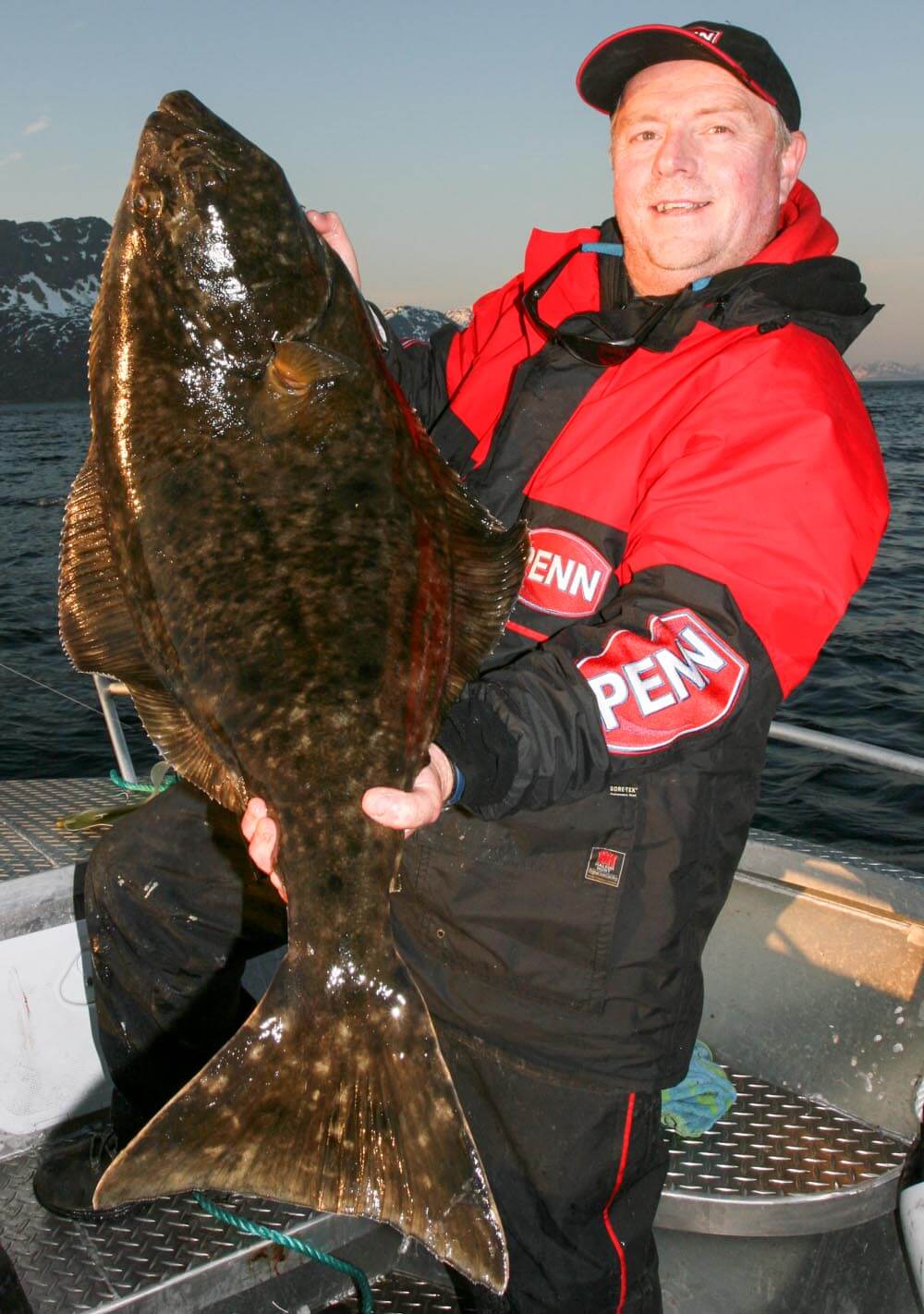
The following day the wind was strong, so being as this was a fact finding mission Ian and I worked the boat literally along the town’s jetty taking coalies and cod on spinners. When Barney joined us we decided to tie up tight to the end of the jetty and fish in to about 20ft of water for dabs and codling.
Barney was catching dabs like the rest of us when all of sudden his rod curved over and whatever was hooked took off. We thought at first it was a decent coalie as the fight was quite lively. Next thing a decent looking halibut was just a few feet down off the boat. I lifted the fish in and it looked to be a good double, but went about 12lbs on the scales. A decent sized halibut caught two metres out from the local jetty. Halibut off the shore are a certainty here fishing fillets of coalie!
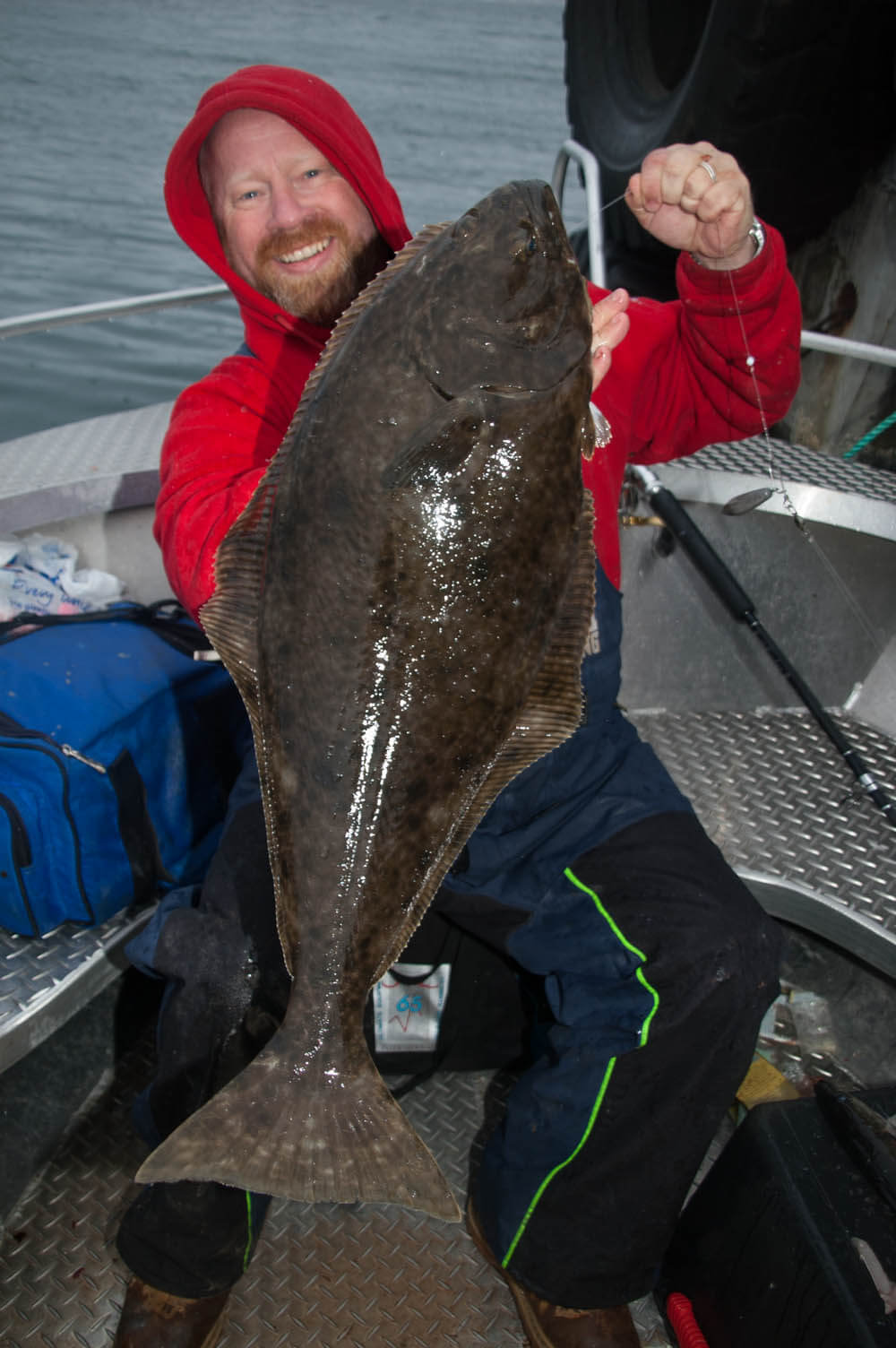
On the last day we had just a few more drifts in the morning at Oyvika where we’d had the three halibut before. Ian was fishing a pirk and hit a slow, somewhat lethargic fish that we were all sure would be a wolffish, but again the chorus “It’s a halibut” broke the silence and this one went about 12lbs. Even in the boat this fish didn’t really wake up, but when it went back in to the water, one flap of its mighty tail and it was heading back for the seabed.
The trip yielded each of us two halibut and we’d learnt a lot. Ian undoubtedly lost a much bigger fish early in the trip that took a pirk worked over deeper outside ground that ripped line off the reel rapidly until the hook pulled out. I also lost a fish that felt heavy and took line off the reel running along the seabed when we were working a drift opposite the fjord mouth under Stjernoey Island.
The Oksfjord area offers incredible ground composition that just screams halibut in so many areas. We were there early in the year after a harsh winter, but certainly in April and May and again in September and October I think the halibut fishing would be outstanding, but at any time of year you’ll catch them and there’s always the chance of a real giant of a flattie.
WHERE AND WHEN TO FISH
You can catch halibut anywhere here, but if the weather is bad try inside the fjord opposite Oksfjord town at Tverrfjordneset.
Outside Oksfjorden look at Oyvika Bay, alternatively at the western end of Stjernoey Island out from Selkeila and shown on the boats charts is a series of rising peaky ground called Eggegrunnen, Kvaeban, Skarvsk, Langskjaergr and Kariholmgrunnen. West of the fjord mouth look at Smaljingrunnen, Breitindgrunnen, Storbaen, and the fjords mouth Landbaen. All these fish exceptionally well.
Fish any rising and falling ground, deep drop offs, and also muddy broken ground from 20-metres to 100-metres plus. You rarely find sharp teeth like rocks, most are round topped because of the ice cutting action millennia ago.
You’ll catch fish anytime of day, but with 24 hour daylight from early May on, try to fish the late afternoon and through twilight just as the sun touches the horizon for the best action.
HALIBUT TACKLE
Both Ian and I were using MTI 20/40’s armed with Penn TRQ100 reels and 30lb braid. Ian fishes an 80lb mono leader straight through, but I prefer a 40lb Fluorocarbon leader as I find it much more resilient to scuffs and scratches. Barney used a Shimano 30lb class rod and reel and this line class will, in the right hands, master most halibut. Only when you get up against fish well over a100lbs would a 50lb class seem the better choice.
For both pirk fishing and when working the Giant Jigheads, I tie a Sakuma size 2/0 swivel to the end of my leader, then add 6ft of 80lb mono, and tie on another 2/0 swivel and attach a Mustad 3/0 oval splitring to this to form my link. The swivels and link are ultra tough and will land massive fish. I don’t trust normal links at all. Ball-bearing big game swivel links would be ok though. The 80lb mono just gives that extra bit of strength to hold the fish on at the side of the boat if need be.
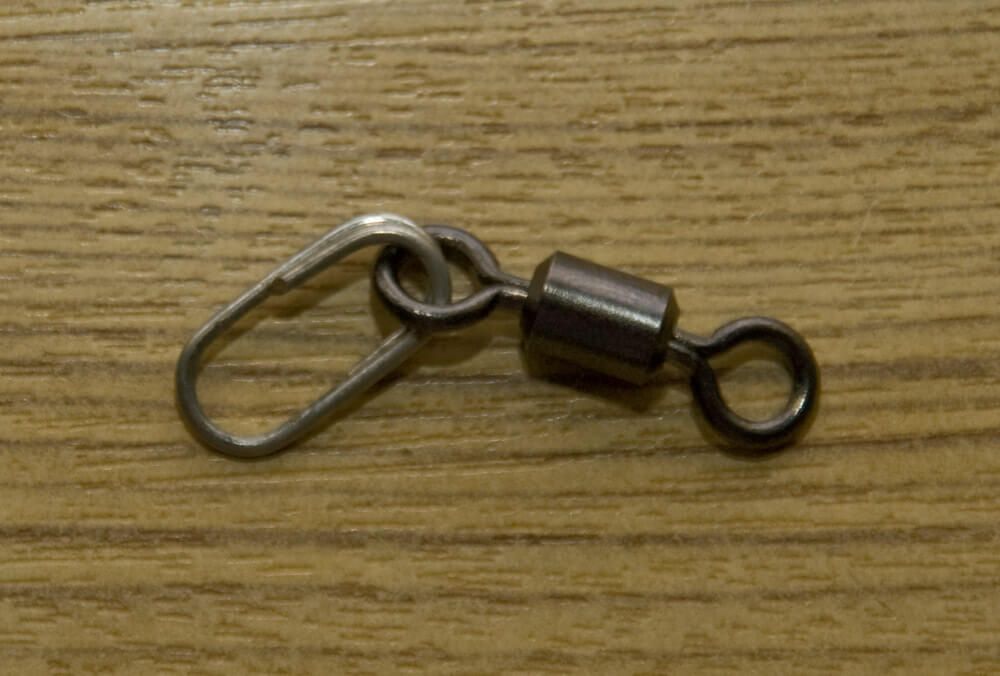
Take pirks up to 500gms, though I rarely use more than 300gms unless the wind is really strong and adding major speed to the boats drift. Good pirks are speed jigs and the Norwegian pirks that flutter, but adding a lumo muppet to the hook gives added attraction.
As mentioned, I prefer the Giant Jigheads above pirks and use 200, 300 and 400gm sizes mostly in conjunction with shads of 6-inch, 8-inch and 10-inch, and 8-inch grubs. Choose jigheads in orange/yellow, blue/white and Green/white and shads in white, luminous and anything dark, the dark ones are the real killers. I sometimes use a permanent marker to colour the dark shads black.
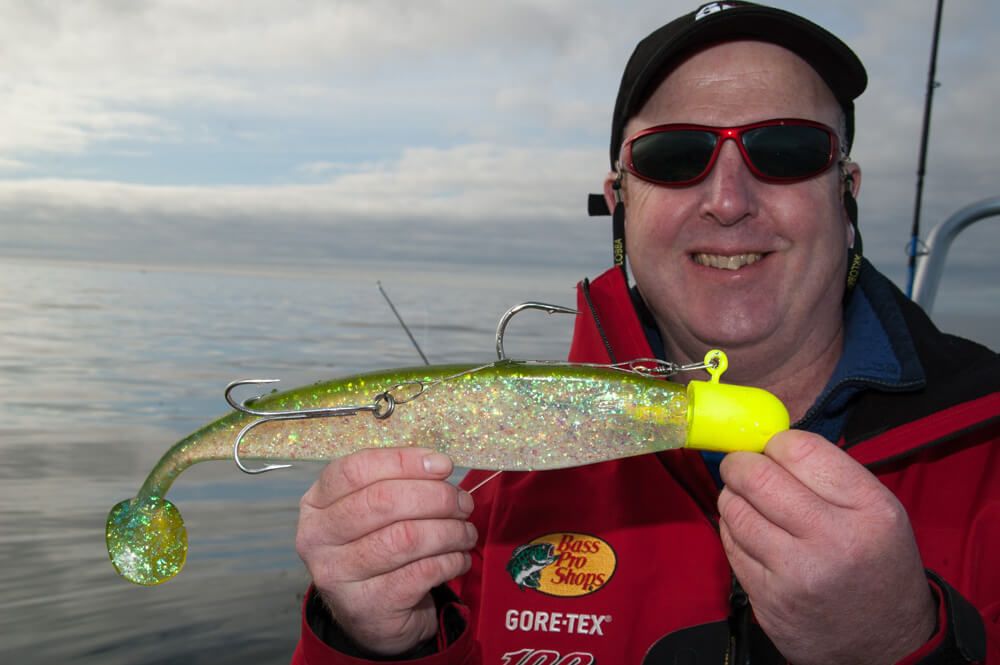
Make sure all your hooks are good quality. The jaws of a halibut will bend cheap hooks out or snap them. I use Mustad trebles but Owner are also excellent. Also pay attention to the split rings on lures. Check they are good quality. If in doubt, change to better ones and price is a good indicator of quality.
You don’t lose much gear in Norway, at least I never have due to the rocks being carved by ice they tend to be smooth and rarely snag your gear. A couple of pirks or jigheads over a week is about it normally, so you don’t need silly numbers of lures. I usually take three of each jighead and a few pirks, some small spinners, spare braid and backing, some links, spare hooks and a few bits to make up traces should I need to. The shads can get ripped by halibut and wolffish, but again three or four of each size will probably do you.
GENERAL COMMENTS
Take good waterproofs, two pairs of sunglasses, two hats in case you lose one, and plenty of sun cream. It may be cool at times, but you’ll still burn in the sun, which can get very hot at times and catch you off guard. Boots or short wellies are good on the boat for footwear. Some gloves are handy if you're bringing the boat in in the early hours of the morning when the sun is low and it’s at its coldest.
ACCOMMODATION, SERVICES & BOATS
We stayed at Oksfjord Sjofiske in the centre of Oksfjord.
The accommodation currently comprises five separate apartments all sleeping six people, are beautifully decorated and exceptionally well equipped. There’s a storage and drying room in the basement for clothes and tackle, plus fish freezers.
The boats are 19ft aluminium Kaevo boats, some twelve in number, capable of fishing three comfortably, powered by Suzuki 50hp outboards and fitted with Garmin 521S sounder/plotters. The boats are moored a short 3 minute walk away. Fuel is available just above where the boats are moored and can be paid for after working hours by credit card at the pump.
Adjacent to the apartments in a bar serving food and beer, just across the road is a supermarket carrying basic supplies with another good supermarket just down the road, also a bank with a cash machine. All the shops take common credit cards.
TRAVEL & BOOKINGS
We flew from Manchester to Oslo, then took an internal flight to Alta. The owners of the Oksfjord Sjofiske, Brynjar and Gry Seljevold, can organise pick up and transport for you from and returning to the airport to make things really easy. You can also fly from Edinburgh, London, Newcastle and numerous other local airports.
You can book to stay and fish on Oksfjord through Ian Peacock, Din Tur UK, Unit 1B, Cromwell Business Park, Hartlepool, TS24 7LR. Tel; 01429-866814. E-mail: peacock@dintur.co.uk Ian is highly experienced in organising Norwegian holiday’s for anglers and is an excellent angler himself. He can answer any questions on halibut or general fishing you may have and advise on the best possible package to suit your group.
These are special fish, immensely powerful, possessors of a wide tail giving them power, agility and a fast attack style. When halibut hit the lure its like an express train slamming in to a brick wall!
My only real chance of catching halibut is when I can get up in to the far north of Norway, which is all too rare. Here the clean, deep, sea fjords with their undersea mountains form the perfect habitat for this incredible fish.
I was representing WSF as part of a three man team comprising Ian Peacock, UK representative for Din Tur, the Norwegian adventure holiday company, and Editor of Total Sea Fishing magazine Barney Wright.
Our base was Oksfjord Sjofiske, a brand new angling centre based in Oksfjord in the county of Finnmark. The centre opens up virgin angling water and our little group was one of the very first to test the potential. There were no established marks in the chart plotter to work from, whatever we did would be by experimentation alone.
Looking over the charts we identified several areas we thought might produce halibut, but then halibut never read the script.
It was the second day and previously on the first night Ian and I had had quite a few cod just a couple of hundred yards or so out from the harbour breakwater in 25-metres of water so we elected to have a few drifts here first. I was fishing a yellow and red speed jig with a luminous muppet on the hook, just working it casually up off the seabed a few feet. Day dreaming of cod I wasn’t ready for the steam train take. Something whacked the pirk and turned straight back for the seabed.
It was a lively fight with the fish just taking a few yards of line now and then but slowly coming up through the water column. Half way up it ripped 10-yards back again then hung in the water. Working the fish it came in to view and a chorus of “It’s a halibut” rang out. Only a little fella some 8½ lbs in weight, but beautifully marked!

Two days later we set our whole day out to try for halibut. We wanted to check out some ground east of the fjord mouth towards a little bay called Oyvika. Here the ground rises to just over 20-metres, but falls quickly in to 100-metres plus. Halibut do seem to favour that 30 to 70-metre depth when you’re fishing close to shore.
It was windy but it helped the boat cover some good ground and the first few drifts produced cod, wolffish and torsk. The highest peak of the underwater ridge was under the boat and we were drifting slowly down the reverse side. Barney had set up with what was basically a Whitby rig comprising a boom and short 6ft trace of 80lb mono ending in a large shad with a curl tail. He was working the rod in short sweeps to give the shad movement. He was just about to lift the rod again when SLAM, his rod curved over and the fish ran for ground. It was stalemate for a moment then pressure lifted the fish and a short way up it went straight back for the seabed. It was a chilly wind coming in from the east, but Barney had beads of sweat on his brow as I picked up my camera and checked the light levels.
The fish made two more short runs then appeared as a blob of white way down. Ian was first to shout “halibut” and it rose through the water and sat quietly on the surface. Lifted aboard we weighed it at 24lbs.

Ian had also changed now to a similar shad on the Whitby rig. A few drifts later we were almost at the bottom of the slope when his rod tip buckled over and line poured off the reel. It stopped only when the fish had run across the seabed a few more yards. He worked the fish hard and gradually it lifted off the seabed but dragged down the rod tip grudgingly as it rose.
It was half way up when the fish thought “enough” turned and went all the way back to the seabed again. The fight was more one sided now and Ian was gaining line quickly. We’d all guessed this was another halibut and sure enough that amazing broad grey/brown back looked up from the depths and broke surface. This one weighed 22lbs.

I was fishing one of Volker Dapoz’s Giant Jigheads in orange/yellow armed with a big black grub. I find these Jigheads highly effective and use them in preference to pirks. They swim like a real fish with limited rod tip movement and give a big silhouette to predators looking upwards off the seabed. My confidence was about to rewarded.
We were almost thinking of calling it quits for the day, but drifting over the peak we’d only dropped in to 30-metres or so just behind a vertical shelf when my Jighead was grabbed by an adversary that went parallel along the seabed for some distance, then stopped. Pumping the fish up off the seabed it hung there barely moving until it was about half way up, then gave away its identity by changing direction and ripping 15-metres of line or more off the reel. I actually felt the fish touch the seabed and turn away as it did so.
We knew what it was now and I played the fish carefully. It broke surface with its tail wide and I expected it powering off again, which it did, but only for few yards and when it came back to the surface it was beaten. This one weighed a sniff over 25lbs on the scales.
A remarkable afternoon’s fishing and it played out well with all three of us catching halibut.

The following day the wind was strong, so being as this was a fact finding mission Ian and I worked the boat literally along the town’s jetty taking coalies and cod on spinners. When Barney joined us we decided to tie up tight to the end of the jetty and fish in to about 20ft of water for dabs and codling.
Barney was catching dabs like the rest of us when all of sudden his rod curved over and whatever was hooked took off. We thought at first it was a decent coalie as the fight was quite lively. Next thing a decent looking halibut was just a few feet down off the boat. I lifted the fish in and it looked to be a good double, but went about 12lbs on the scales. A decent sized halibut caught two metres out from the local jetty. Halibut off the shore are a certainty here fishing fillets of coalie!

On the last day we had just a few more drifts in the morning at Oyvika where we’d had the three halibut before. Ian was fishing a pirk and hit a slow, somewhat lethargic fish that we were all sure would be a wolffish, but again the chorus “It’s a halibut” broke the silence and this one went about 12lbs. Even in the boat this fish didn’t really wake up, but when it went back in to the water, one flap of its mighty tail and it was heading back for the seabed.
The trip yielded each of us two halibut and we’d learnt a lot. Ian undoubtedly lost a much bigger fish early in the trip that took a pirk worked over deeper outside ground that ripped line off the reel rapidly until the hook pulled out. I also lost a fish that felt heavy and took line off the reel running along the seabed when we were working a drift opposite the fjord mouth under Stjernoey Island.
The Oksfjord area offers incredible ground composition that just screams halibut in so many areas. We were there early in the year after a harsh winter, but certainly in April and May and again in September and October I think the halibut fishing would be outstanding, but at any time of year you’ll catch them and there’s always the chance of a real giant of a flattie.
WHERE AND WHEN TO FISH
You can catch halibut anywhere here, but if the weather is bad try inside the fjord opposite Oksfjord town at Tverrfjordneset.
Outside Oksfjorden look at Oyvika Bay, alternatively at the western end of Stjernoey Island out from Selkeila and shown on the boats charts is a series of rising peaky ground called Eggegrunnen, Kvaeban, Skarvsk, Langskjaergr and Kariholmgrunnen. West of the fjord mouth look at Smaljingrunnen, Breitindgrunnen, Storbaen, and the fjords mouth Landbaen. All these fish exceptionally well.
Fish any rising and falling ground, deep drop offs, and also muddy broken ground from 20-metres to 100-metres plus. You rarely find sharp teeth like rocks, most are round topped because of the ice cutting action millennia ago.
You’ll catch fish anytime of day, but with 24 hour daylight from early May on, try to fish the late afternoon and through twilight just as the sun touches the horizon for the best action.
HALIBUT TACKLE
Both Ian and I were using MTI 20/40’s armed with Penn TRQ100 reels and 30lb braid. Ian fishes an 80lb mono leader straight through, but I prefer a 40lb Fluorocarbon leader as I find it much more resilient to scuffs and scratches. Barney used a Shimano 30lb class rod and reel and this line class will, in the right hands, master most halibut. Only when you get up against fish well over a100lbs would a 50lb class seem the better choice.
For both pirk fishing and when working the Giant Jigheads, I tie a Sakuma size 2/0 swivel to the end of my leader, then add 6ft of 80lb mono, and tie on another 2/0 swivel and attach a Mustad 3/0 oval splitring to this to form my link. The swivels and link are ultra tough and will land massive fish. I don’t trust normal links at all. Ball-bearing big game swivel links would be ok though. The 80lb mono just gives that extra bit of strength to hold the fish on at the side of the boat if need be.

Take pirks up to 500gms, though I rarely use more than 300gms unless the wind is really strong and adding major speed to the boats drift. Good pirks are speed jigs and the Norwegian pirks that flutter, but adding a lumo muppet to the hook gives added attraction.
As mentioned, I prefer the Giant Jigheads above pirks and use 200, 300 and 400gm sizes mostly in conjunction with shads of 6-inch, 8-inch and 10-inch, and 8-inch grubs. Choose jigheads in orange/yellow, blue/white and Green/white and shads in white, luminous and anything dark, the dark ones are the real killers. I sometimes use a permanent marker to colour the dark shads black.

Make sure all your hooks are good quality. The jaws of a halibut will bend cheap hooks out or snap them. I use Mustad trebles but Owner are also excellent. Also pay attention to the split rings on lures. Check they are good quality. If in doubt, change to better ones and price is a good indicator of quality.
You don’t lose much gear in Norway, at least I never have due to the rocks being carved by ice they tend to be smooth and rarely snag your gear. A couple of pirks or jigheads over a week is about it normally, so you don’t need silly numbers of lures. I usually take three of each jighead and a few pirks, some small spinners, spare braid and backing, some links, spare hooks and a few bits to make up traces should I need to. The shads can get ripped by halibut and wolffish, but again three or four of each size will probably do you.
GENERAL COMMENTS
Take good waterproofs, two pairs of sunglasses, two hats in case you lose one, and plenty of sun cream. It may be cool at times, but you’ll still burn in the sun, which can get very hot at times and catch you off guard. Boots or short wellies are good on the boat for footwear. Some gloves are handy if you're bringing the boat in in the early hours of the morning when the sun is low and it’s at its coldest.
ACCOMMODATION, SERVICES & BOATS
We stayed at Oksfjord Sjofiske in the centre of Oksfjord.
The accommodation currently comprises five separate apartments all sleeping six people, are beautifully decorated and exceptionally well equipped. There’s a storage and drying room in the basement for clothes and tackle, plus fish freezers.
The boats are 19ft aluminium Kaevo boats, some twelve in number, capable of fishing three comfortably, powered by Suzuki 50hp outboards and fitted with Garmin 521S sounder/plotters. The boats are moored a short 3 minute walk away. Fuel is available just above where the boats are moored and can be paid for after working hours by credit card at the pump.
Adjacent to the apartments in a bar serving food and beer, just across the road is a supermarket carrying basic supplies with another good supermarket just down the road, also a bank with a cash machine. All the shops take common credit cards.
TRAVEL & BOOKINGS
We flew from Manchester to Oslo, then took an internal flight to Alta. The owners of the Oksfjord Sjofiske, Brynjar and Gry Seljevold, can organise pick up and transport for you from and returning to the airport to make things really easy. You can also fly from Edinburgh, London, Newcastle and numerous other local airports.
You can book to stay and fish on Oksfjord through Ian Peacock, Din Tur UK, Unit 1B, Cromwell Business Park, Hartlepool, TS24 7LR. Tel; 01429-866814. E-mail: peacock@dintur.co.uk Ian is highly experienced in organising Norwegian holiday’s for anglers and is an excellent angler himself. He can answer any questions on halibut or general fishing you may have and advise on the best possible package to suit your group.

